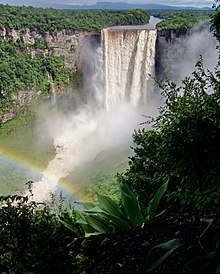Kaieteur Falls
| Kaieteur Falls | |
|---|---|

Kaieteur Falls, Guyana, in rainy season 2004
|
|
| Location |
|
| Coordinates | 5°10′30″N 59°28′49.8″W / 5.17500°N 59.480500°WCoordinates: 5°10′30″N 59°28′49.8″W / 5.17500°N 59.480500°W |
| Type | Plunge |
| Total height | 741 feet/226 metres |
| Number of drops | 1 (tallest single drop waterfall of the world) |
| Longest drop | 741 feet/226 metres |
| Average width | 371 feet/113 metres |
| Watercourse | Potaro River |
| Average flow rate |
23,400 cu ft/s (660 m3/s) |
| World height ranking | 123 |
Kaieteur Falls is the world's largest single drop waterfall by the volume of water flowing over it. Located on the Potaro River in the Kaieteur National Park, it sits in a section of the Amazon rainforest included in the Potaro-Siparuni region of Guyana and claimed by Venezuela as Guayana Esequiba. It is 226 metres (741 ft) high when measured from its plunge over a sandstone and conglomerate cliff to the first break. It then flows over a series of steep cascades that, when included in the measurements, bring the total height to 251 metres (822 ft). While many falls have greater height, few have the combination of height and water volume, and Kaieteur is among the most powerful waterfalls in the world with an average flow rate of 663 cubic metres per second (23,400 cubic feet per second).
Kaieteur Falls is about four times higher than Niagara Falls, on the border between Canada and the United States, and about twice the height of Victoria Falls, on the border of Zambia and Zimbabwe in Africa. It is a single drop waterfall.
Upriver from the falls, the Potaro Plateau stretches out to the distant escarpment of the Pakaraima Mountains. The Potaro River empties into the Essequibo River which is one of the longest and widest rivers in South America and the longest river in Guyana.
The falls were discovered in 1870 by a party led by Charles Barrington Brown, a pair of British geologists appointed as government surveyors to the colony of British Guiana. Brown and his partner James Sawkins had arrived in Georgetown in 1867, and while they did some of their mapping and preparation of geological reports together, some work was performed in separate expeditions, and Sawkins was taking a break from his work at the time of Brown's discovery of Kaieteur. At this point, Brown did not have time to investigate Kaieteur Falls closer, so he returned one year later to make comprehensive measurements.
...
Wikipedia
